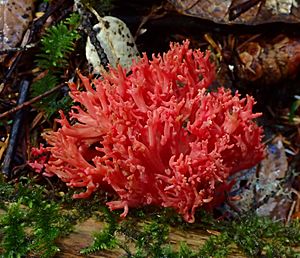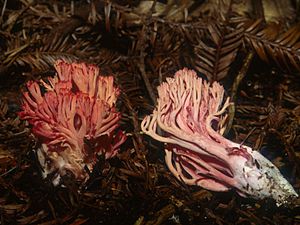Red coral facts for kids
Quick facts for kids Red coral |
|
|---|---|
 |
|
| Scientific classification | |
| Genus: |
Ramaria
|
| Species: |
araiospora
|
The Ramaria araiospora, often called the red coral mushroom, is a type of coral mushroom. It belongs to the Gomphaceae family. This mushroom was first officially described in 1974. You can find it in North America and the Himalaya mountains. It's a mushroom that people can eat, and it's even sold in local markets in Mexico.
Contents
What is the Red Coral Mushroom?
The Ramaria araiospora is a fungus that looks a bit like coral found in the ocean. Its scientific name was given by two mycologists (scientists who study fungi), Currie Marr and Daniel Stuntz. They described it in their book about Ramaria mushrooms in western Washington in 1974. The very first sample of this mushroom was found in 1967 in Pierce County, Washington.
This mushroom is commonly known as the "red coral" because of its bright color and branched shape.
How Does It Look?
The fruiting bodies (the part of the mushroom you see) of the red coral mushroom usually grow to be about 5 to 14 centimeters (2 to 5.5 inches) tall. They can be 2 to 10 centimeters (about 1 to 4 inches) wide.
It has a single, slightly thick stem at the bottom, which is about 2 to 3 centimeters (1 inch) long. This stem then branches out up to six times. The smaller branches are thin, usually 1 to 5 millimeters wide. The branches closer to the bottom are thicker, up to 4 centimeters wide. The very tips of the branches are often forked or finely divided into sharp points.
When the mushroom is young, its inside (called the context) is fleshy. As it gets older, it becomes more brittle when it dries. The branches are bright red at first, but they become a lighter red as the mushroom gets older. The stem and base are white or yellowish-white. The tips of the branches are yellow. When the mushroom dries out, its base turns yellowish-white, and the branches become a dull red. This mushroom does not have a strong smell or taste.
Tiny Details: Spores and Cells
The spores of this mushroom are white, cream, or yellowish. They are shaped like small cylinders and have tiny bumps on them. The cells that produce the spores are called basidia. They are club-shaped and usually produce four spores.
Where Does the Red Coral Mushroom Grow?
This mushroom likely forms a special partnership with trees, where both the mushroom and the tree help each other grow. It grows on the ground, either alone or in small groups. You can often find it under conifer trees, like western hemlock, and also under deciduous trees, such as tanoak.
The red coral mushroom usually appears in September and November. It is mostly found in the Pacific Northwest area of North America. A very similar mushroom has also been seen in Kansas. A specific type of this mushroom, called rubella, has been found in the eastern Himalaya mountains and in Mexico.
Can You Eat the Red Coral Mushroom?
Yes, the red coral mushroom is considered edible. However, eating it can sometimes cause an upset stomach for some people.
In a place called Villa del Carbón in Mexico, these mushrooms are very popular. Locals have special names for them, like patitas de pájaro ("bird's legs"), patitas temblonas ("trembling legs"), or patitas rojas ("red legs"). People like them because they are fleshy, have a mild flavor, and are easy to find. They are often sold in markets in bundles weighing about 480 grams (which is about 15 mushrooms).
Similar Looking Mushrooms
There are other mushrooms that look a lot like the red coral. For example, Ramaria stuntzii looks similar but has a larger base and reddish-orange branches below. Another one, R. cyaneigranosa, is also very similar, but you would need to look at its tiny details under a microscope to tell the difference.
See also
 In Spanish: Ramaria araiospora para niños
In Spanish: Ramaria araiospora para niños


